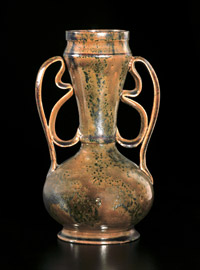[av_slideshow_full size=’no scaling’ stretch=” animation=’fade’ autoplay=’false’ interval=’5′ control_layout=’av-control-default’ src=” attachment=” attachment_size=” position=’top left’ repeat=’no-repeat’ attach=’scroll’]
[av_slide_full slide_type=’image’ id=’60170′ video=” mobile_image=” video_format=” video_ratio=” title=’George Ohr Pottery:
Method in His Madness’ custom_title_size=’48’ custom_content_size=’20’ caption_pos=’caption_center’ link_apply=” link=’lightbox’ link_target=” button_label=” button_color=’light’ link1=’manually,http://’ link_target1=” button_label2=” button_color2=’light’ link2=’manually,http://’ link_target2=” font_color=’custom’ custom_title=’#ffffff’ custom_content=’#ededed’ overlay_enable=’aviaTBaviaTBoverlay_enable’ overlay_opacity=’0.1′ overlay_color=’#444444′ overlay_pattern=” overlay_custom_pattern=”]
BY KARLA KLEIN ALBERTSON
[/av_slide_full]
[/av_slideshow_full]
[av_textblock size=” font_color=’custom’ color=’#ffffff’]
Interior of the George E. Ohr pottery workshop, Biloxi, Mississippi, 1901. Detroit Publishing Co. image. Library of Congress Prints and Photographs Division Washington, D.C.
[/av_textblock]
[av_section min_height=” min_height_px=’500px’ padding=’default’ shadow=’no-border-styling’ bottom_border=’no-border-styling’ id=” color=’main_color’ custom_bg=’#f2f2f2′ src=” attachment=” attachment_size=” attach=’scroll’ position=’top left’ repeat=’no-repeat’ video=” video_ratio=’16:9′ overlay_opacity=’0.5′ overlay_color=” overlay_pattern=” overlay_custom_pattern=”]
[av_one_full first min_height=” vertical_alignment=’av-align-top’ space=” margin=’0px’ margin_sync=’true’ padding=’10px,20px,10px,20px’ border=’1′ border_color=’#eaeaea’ radius=’0px’ radius_sync=’true’ background_color=’#ffffff’ src=” attachment=” attachment_size=” background_position=’top left’ background_repeat=’no-repeat’]
[av_hr class=’invisible’ height=’20’ shadow=’no-shadow’ position=’center’ custom_border=’av-border-thin’ custom_width=’50px’ custom_border_color=” custom_margin_top=’30px’ custom_margin_bottom=’30px’ icon_select=’yes’ custom_icon_color=” icon=’ue808′ font=’entypo-fontello’]
[av_textblock size=” font_color=” color=”]
Even in the progressive heyday of the American art pottery movement at the turn of the 20th century, the works of Mississippi potter George E. Ohr (1857-1918) were considered avant-garde.
[/av_textblock]
[av_hr class=’invisible’ height=’20’ shadow=’no-shadow’ position=’center’ custom_border=’av-border-thin’ custom_width=’50px’ custom_border_color=” custom_margin_top=’30px’ custom_margin_bottom=’30px’ icon_select=’yes’ custom_icon_color=” icon=’ue808′ font=’entypo-fontello’]
[av_textblock size=’16’ font_color=’custom’ color=’#686868′]
His sculptural handmade pottery – he claimed no two were alike – resembled nothing turned out by his contemporaries. His bohemian behavior and unusual appearance, recorded in a series of mischievous period photographs, earned him the title of “The Mad Potter of Biloxi.”
Eugene Hecht, authority on the potter and a professor of physics, wrote, “Ohr was an incomparable technician, an uncanny colorist, an exquisitely sensual soul, a totally committed, egocentric, eccentric, vulnerable genius who created a body of artistic work that rivals any produced in this country.”
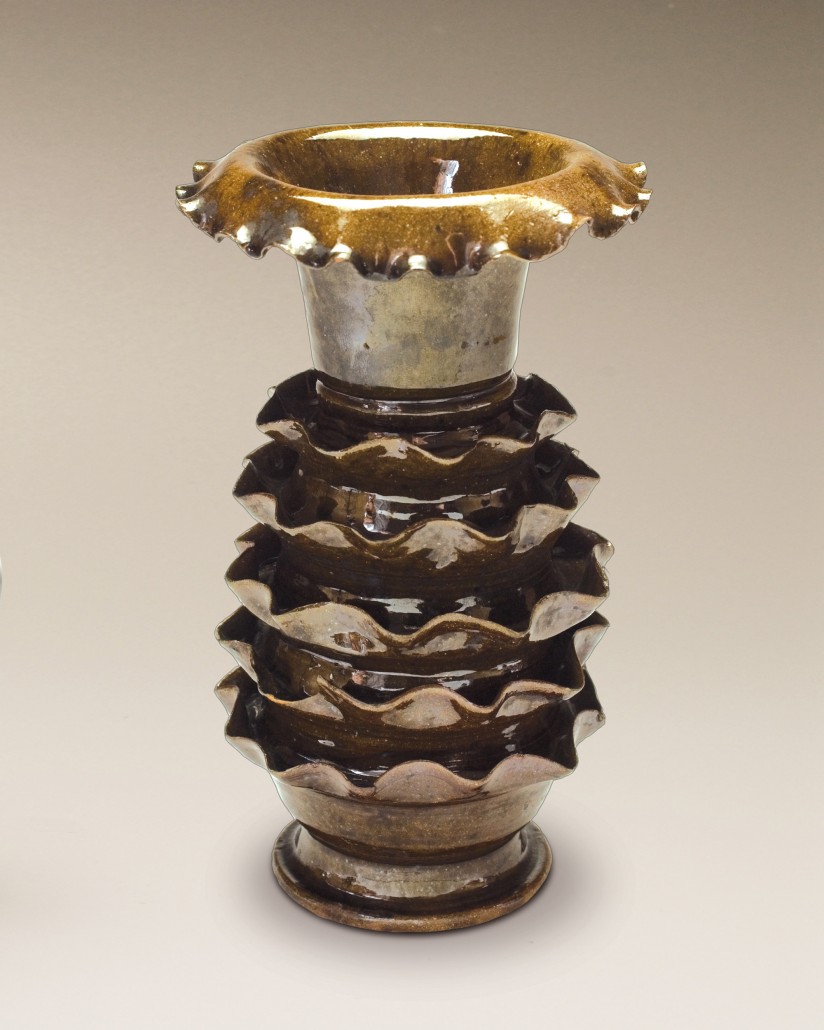
Like many other artists, Ohr’s work was not fully appreciated in his own time. Thousands of unsold pieces slumbered in storage on family property after his death. The entire collection was purchased by an East Coast dealer in 1972, and only then did the highly manipulated vases and vessels find enthusiastic appreciation and an avid market among art collectors.
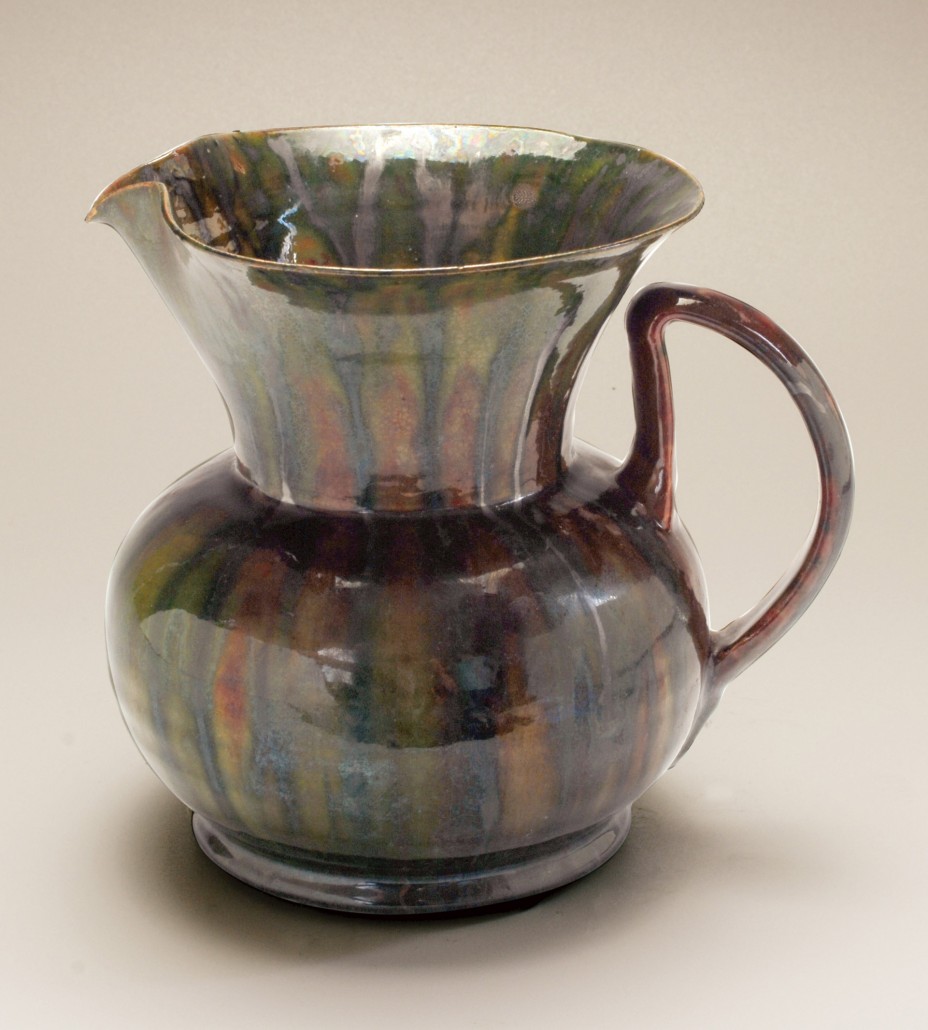
With little formal education, Ohr learned to make pottery as an apprentice to Joseph Meyer and then traveled around the East and Midwest to view the works of other craftsmen. He set up his own pottery in his hometown of Biloxi in 1883 and took a first batch of work to a World’s Fair in nearby New Orleans the following year.
[/av_textblock]
[av_hr class=’invisible’ height=’50’ shadow=’no-shadow’ position=’center’ custom_border=’av-border-thin’ custom_width=’50px’ custom_border_color=” custom_margin_top=’30px’ custom_margin_bottom=’30px’ icon_select=’yes’ custom_icon_color=” icon=’ue808′ font=’entypo-fontello’]
[av_heading tag=’h3′ padding=’10’ heading=’“Few people could have crafted pots so thin, and no one else thought to alter them in such bizarre ways.”’ color=’custom-color-heading’ style=’blockquote classic-quote’ custom_font=’#020202′ size=’44’ subheading_active=” subheading_size=’15’ custom_class=”][/av_heading]
[av_hr class=’invisible’ height=’50’ shadow=’no-shadow’ position=’center’ custom_border=’av-border-thin’ custom_width=’50px’ custom_border_color=” custom_margin_top=’30px’ custom_margin_bottom=’30px’ icon_select=’yes’ custom_icon_color=” icon=’ue808′ font=’entypo-fontello’]
[av_textblock size=’16’ font_color=’custom’ color=’#686868′]
With little formal education, Ohr learned to make pottery as an apprentice to Joseph Meyer and then traveled around the East and Midwest to view the works of other craftsmen. He set up his own pottery in his hometown of Biloxi in 1883 and took a first batch of work to a World’s Fair in nearby New Orleans the following year.
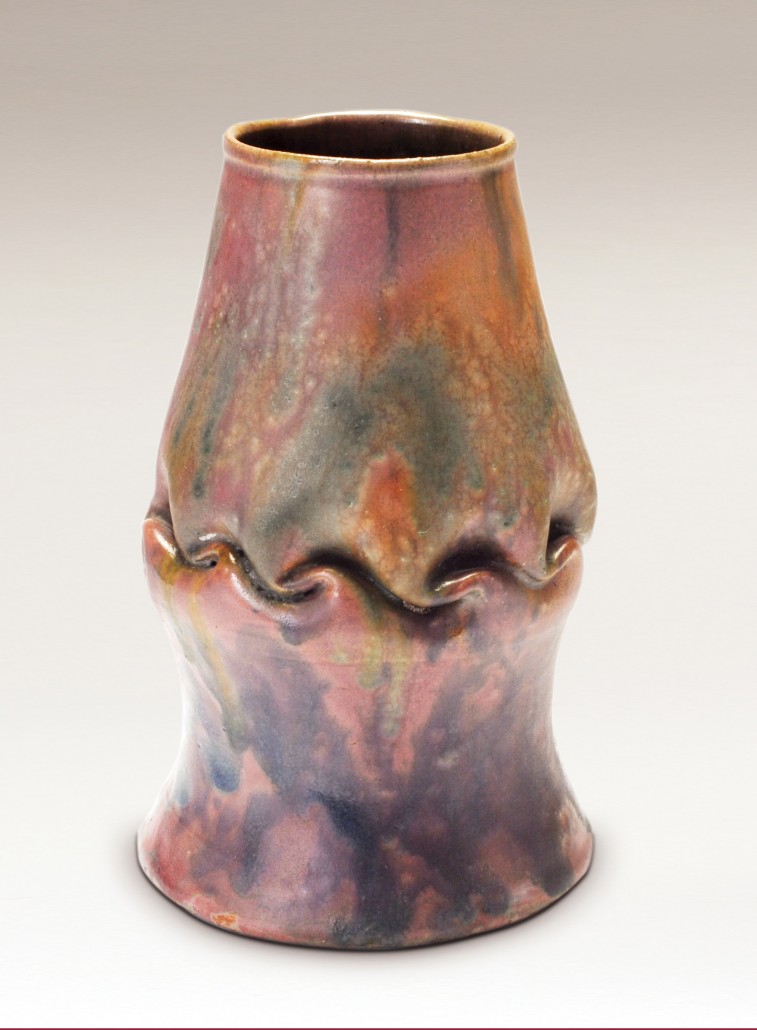
A turning point in his career was a major fire in the town that destroyed his pottery and 10 years’ worth of work in 1894. Ohr quickly rebuilt and the ceramics so admired by collectors today were made between 1895 and around 1907. As the Biloxi Art Pottery, he showed his wares in the Mississippi State Exhibition at the Louisiana Purchase International Exposition of 1904 (St. Louis World’s Fair). The judges awarded him a Silver Medal, but the designs remained too extreme for consumers and nothing in the display was sold.
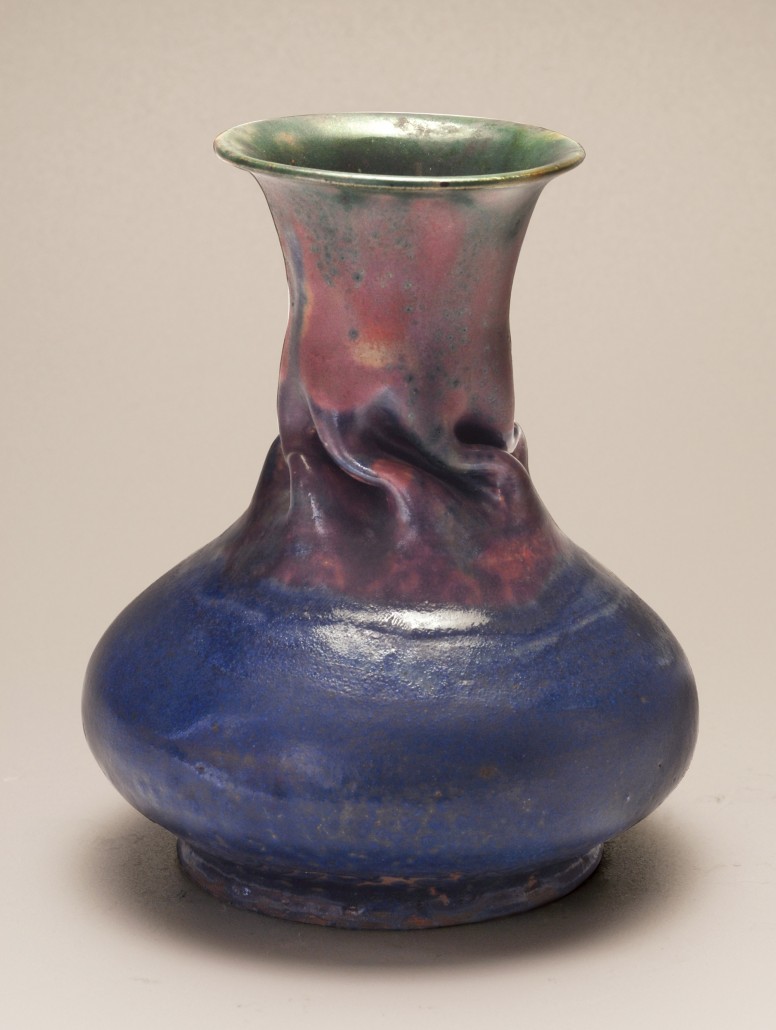
A comparison of George Ohr’s work with contemporary ceramics made by well-known art potteries such as Rookwood or Grueby reveals the stylistic risks taken by the Biloxi potter. Although in hopes of a sale, he made traditional forms such a vases, pitchers and teapots, his creative mind transformed these familiar shapes. Vases have eccentric looped handles and glazes in shocking reds and greens. Pitchers are crumpled and deformed.
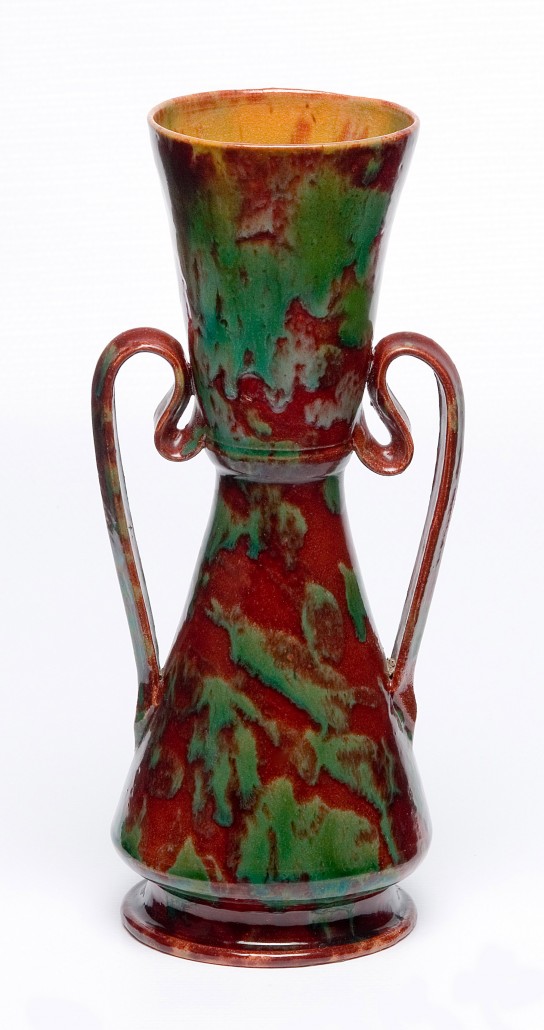
After exploring the infinite possibilities of colored glazes, he later made unglazed works – sometimes in mottled clay – where all the artistry is in the shape. Each work captures a moment of inspiration. Auction house owner David Rago has written extensively about Ohr’s work, emphasizing “his forms, thrown paper thin and manipulated with twists, crinkles, dimples and folds. Few people could have crafted pots so thin, and no one else thought to alter them in such bizarre ways.”
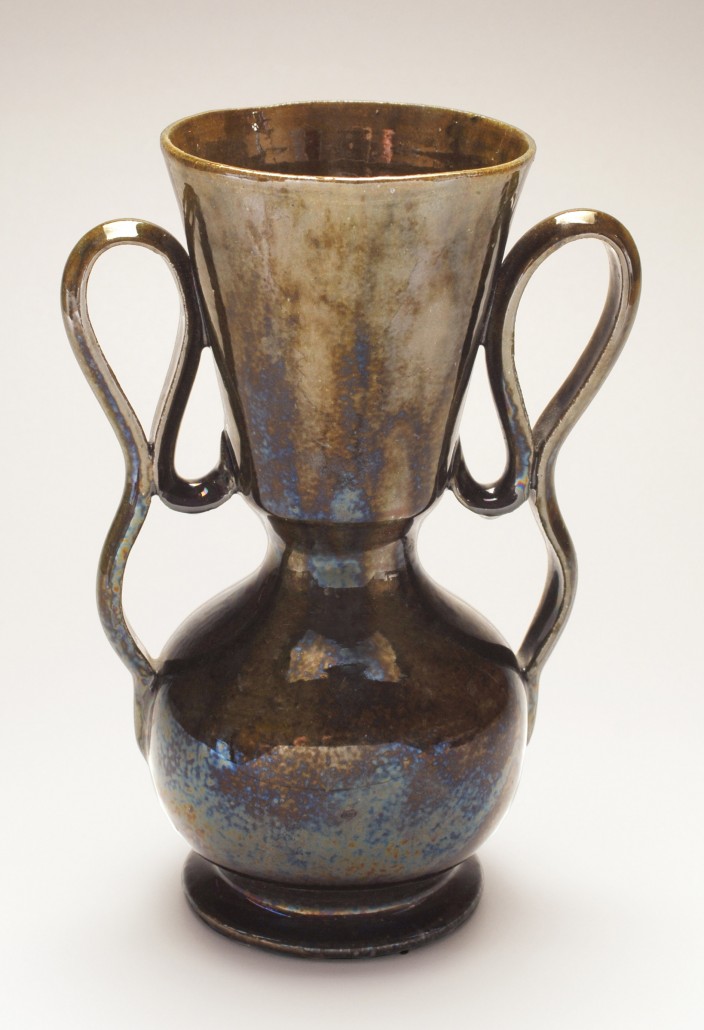
Rago says of the market, “The most expensive of Ohr’s pots, and the most desirable to collectors, are those that combine bright, imaginative colors with intense manipulation of form.” George Ohr’s ceramics command prices in the five- to six-figure range.
For more biographical information and images of the potter’s best work, the classic reference remains The Mad Potter of Biloxi: The Art & Life of George E. Ohr by Garth Clark, Robert A. Ellison Jr. and Eugene Hecht (Abbeville).
[/av_textblock]
[/av_one_full][/av_section][av_one_full first min_height=” vertical_alignment=’av-align-top’ space=” margin=’0px’ margin_sync=’true’ padding=’80px,40px,80px,40px’ border=’1′ border_color=’#eaeaea’ radius=’0px’ radius_sync=’true’ background_color=’#ffffff’ src=” attachment=” attachment_size=” background_position=’top left’ background_repeat=’no-repeat’]
[av_textblock size=” font_color=” color=”]
 About Karla Klein Albertson
About Karla Klein Albertson
Karla Klein Albertson focuses on the decorative arts, from excavated antiquities to contemporary pop-culture icons. She currently writes the Ceramics Collector column and exhibition features for Auction Central News, covers shows and auctions for the Maine Antique Digest, and authors the Antiques column in The Philadelphia Inquirer. She holds a master’s degree in classical archaeology from Bryn Mawr College.
[/av_textblock]
[/av_one_full]
[av_hr class=’invisible’ height=’50’ shadow=’no-shadow’ position=’center’ custom_border=’av-border-thin’ custom_width=’50px’ custom_border_color=” custom_margin_top=’30px’ custom_margin_bottom=’30px’ icon_select=’yes’ custom_icon_color=” icon=’ue808′ font=’entypo-fontello’]
[av_one_fifth first min_height=” vertical_alignment=” space=” custom_margin=” margin=’0px’ padding=’0px’ border=” border_color=” radius=’0px’ background_color=” src=” background_position=’top left’ background_repeat=’no-repeat’][/av_one_fifth]
[av_four_fifth min_height=” vertical_alignment=” space=” custom_margin=” margin=’0px’ padding=’0px’ border=” border_color=” radius=’0px’ background_color=” src=” background_position=’top left’ background_repeat=’no-repeat’]
[av_sidebar widget_area=’SCM – 728×90 – footer’]
[/av_four_fifth]


